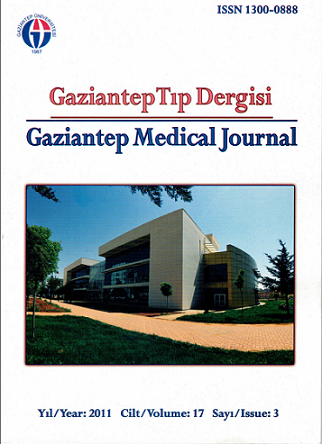Clinical profile of childhood focal epilepsies in Jordan
Ürdün’de çocukluk çağı fokal epilepsilerin klinik profili
DOI:
https://doi.org/10.5455/GMJ-30-2011-48Keywords:
Complex partial seizure, epilepsy, simple partial seizureAbstract
The present study was done in order to obtain a baseline profile of childhood focal epilepsies. Subjects included in this study were children suffering from focal epilepsy with age above 2 years who attended the Pediatric Neurology Clinic in Queen Rania Hospital for Children in Jordan. The data were obtained: age, sex, detailed of seizures type, age at first unprovoked seizure, family history of seizures, history of febrile seizures, etiological, socioeconomic class, additional neuro-impairment, electroencephalography (EEG) and brain imaging finding and the use of antiepileptic drugs, the results were recorded for further study. A total of 100 cases of focal epilepsy were enrolled in the study, 59 were male. Simple partial type recorded in 48%, simple partial with secondary generalization in 17% and complex partial seizure in 35%. In partial onset seizures the peak age was between 11-14 years and complex partial seizures between ages 6-10 years. Twenty-six patients had a family history of epilepsy, 91% of low socioeconomic class. Thirteen % of cases have history of febrile seizures, while symptomatic epilepsy was found in 48%. Twenty-five children had hypoxic-ischemic encephalopathy. The most common neurological impairment was learning difficulties with 35%. EEG was normal in 20% and monotherapy was used in 68% and 33% had bad control (intractable). The pattern of focal epilepsies in our country do not differ from that of developed countries, identifying the etiology is important to plan prevention.
Metrics
References
Radhakrishnan K, Pandian JD, Santhoshkumar T, Thomas SV, Deetha TD, Sarma PS, et al. Prevalence, knowledge, attitude, and practice of epilepsy in Kerala, South India. Epilepsia 2000;41(8):1027-35.
Banerjee PN, Hauser WA. Incidence and prevalence. In: Engel J Jr, Pedley TA, editors. Epilepsy: A Comprehensive Textbook. 2nd ed. Philadelphia, PA: Wolters Kluwer Lippincott Williams Wilkins; 2008. 45-56.
Oka E, Ishida S, Ohtsuka Y, Ohtahara S. Neuroepidemiological study of childhood epilepsy by application of international classification of epilepsies and epileptic syndromes (ILAE, 1989). Epilepsia 1995;36(7):658-61.
Dalla Bernardina B, Sgro V, Fontana E, Colamaria V, Selva L. Idiopathic partial epilepsies in childhood. In: Advances of Epileptology, NewYork, Raven Press, 1992, 173-18.
Velez A, Eslava-Cobos J. Epilepsy in Colombia: epidemiologic profile and classification of epileptic seizures and syndromes. Epilepsia 2006;47(1):193-201.
Commission on Epidemiology and Prognosis, International Leaque Against Epilepsy. Guidelines for epidemiologic studies on epilepsy. Epilepsia 1993;34(4):592-6.
Blume WT. Diagnosis and management of epilepsy. CMAJ 2003;168(4):441-8.
Beilmann A, Napa A, Soot A, Talvik I, Talvik T. Prevalence of childhood epilepsy in Estonia. Epilepsia 1999;40(7):1011-9.
Waaler PE, Blom BH, Skeidsvoll H, Mykletun A. Prevalence, classification, and severity of epilepsy in children in western Norway. Epilepsia 2000;41(7):802-10.
Hauser WA. Epidemiology of epilepsy in children. Neurosurg Clin N Am 1995;6(3):419-29.
Braathen G, Theorell K. A general hospital population of a childhood epilepsy. Acta Paediatr 1995;8(10):1143-6.
Callenbach PM, Geerts AT, Arts WF, van Donselaar CA, Peters AC, Stroink H, et al. Familial occurrence of epilepsy in children with newly diagnosed multiple seizures: Dutch Study of Epilepsy in Childhood. Epilepsia 1998;39(3):331-6.
Daoud AS, Batieha A, Bashtawi M, El-Shanti H. Risk factors for childhood epilepsy: a case-control study from Irbid, Jordan. Seizure 2003;12(3):171-4.
Berg AT, Shinnar S, Levy SR, Testa FM. Childhood-onset epilepsy with and without preceding febrile seizures. Neurology 1999;53(8):1742-8.
Sillanpaa M, Jalava M, Kaleva O, Shinnar S. Long-term prognosis of seizures with onset in childhood. N Engl J Med 1998;338(24):1715-22.
Raroque HG Jr, Purdy P. Lesion localization in periodic lateralized epileptiform discharges: gray or white matter. Epilepsia 1995;36(1):58-62.
Clarke DF, Roberts W, Daraksan M, Dupuis A, McCabe J, Wood H, et al. The prevalence of autistic spectrum disorder in children surveyed in a tertiary care epilepsy clinic. Epilepsia 2005;46(12):1970-7.
Freitag CM, May TW, Pfafflin M, Konig S, Rating D. Incidence of epilepsies and epileptic syndromes in children and adolescents: a population-based prospective study in Germany. Epilepsia 2001;42(8):979-85.
Banu SH, Khan NZ, Hossain M, Jahan A, Parveen M, Rahman N, et al. Profile of childhood epilepsy in Bangladesh. Dev Med Child Neurol 2003;45(7):477-82.
Al-Sulaiman AA, Ismail HM. Clinical pattern of newlydiagnosed seizures in Saudia Arabia: a prospective study of 263 children. Childs Nerv Syst 1999;15(9):468-71.
Abbashar H, Ammar E. The pattern and treatment of epilepsy among Sudanese epileptic patients. Emirates Medical Journal 2006;24:54-58.
Reynolds EH, Shorvon SD. Monotherapy or polytherapy for epilepsy? Epilepsia 1981;22(1):1-10.
Carpay HA, Arts WF, Geerts AT, Stroink H, Brouwer OF, Boudewyn Peters AC, et al. Epilepsy in childhood: an audit of clinical practice. Arch Neurol 1998;55(5):668-73.
Niaz FE, Abou-Khalil B, Fakhoury T. The generalized tonic clonic seizure in partial versus generalized epilepsy: semiologic differences. Epilepsia 1999;40(11):1664-6.
Downloads
Published
How to Cite
Issue
Section
License
Copyright (c) 2023 European Journal of Therapeutics

This work is licensed under a Creative Commons Attribution-NonCommercial 4.0 International License.
The content of this journal is licensed under a Creative Commons Attribution-NonCommercial 4.0 International License.


















